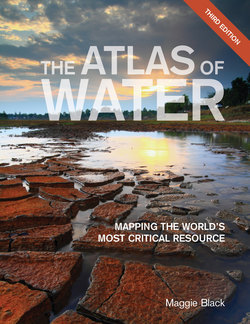Читать книгу The Atlas of Water - Maggie Black - Страница 19
На сайте Литреса книга снята с продажи.
ОглавлениеWater’s Unequal Distribution
The amount of water that falls as rain, filling lakes, rivers, streams and aquifers, is more than enough to meet our needs, but it is unevenly distributed across the Earth. The floodplains of major rivers have water in abundance, and the need to control and deploy water within them helped prompt the birth of civilizations. In arid zones, tropical and frozen, lack of water constrains human settlement and very different societies have emerged. In temperate areas with steady and reliable rainfall, much of which soaks into the ground, it has been relatively easy to manage freshwater flows so as to secure supplies and prevent floods. In water-short areas, and those where storms wreak havoc, water security is more difficult and societies typically poorer. There is also pressure on freshwater resources from population growth, urbanization, and increasingly industrialized lifestyles. In some desert settings, a traditionally well-adapted way of life has given way to water-profligacy – swimming pools, intensive irrigation – beyond the capacity of local renewable resources. In some parts of the world, notably in Asia, the whole year’s rainfall comes in a brief torrential season, complicating agricultural practice. The storage of water and its channelling via hydraulic infrastructure helps redress this problem. But there is a price to be paid by downstream populations, whose fishing or farming economies are jeopardized by major alterations in water pathways and flows.
Brazil
The Amazon region receives nearly 75% of Brazil’s water, but is very lightly populated. The northeast coastal region, where 20% of people live, receives only 2%.
Both China and India face extreme disparities between their share of the world’s water and of its population, prompting China to propose ambitious projects to shift water between major rivers.
North America
All types of aridity zones are to be found in North America, and for millennia its indigenous peoples lived sustainably off the land. As European settlers moved across the country from east to west they also developed technologies that enabled them to survive in some of the harshest environments, but their use of the available water is not always sustainable in the long-term. Las Vegas, sprawling across the Nevada Desert, relies on the waters of the steadily shrinking Lake Mead.
22
